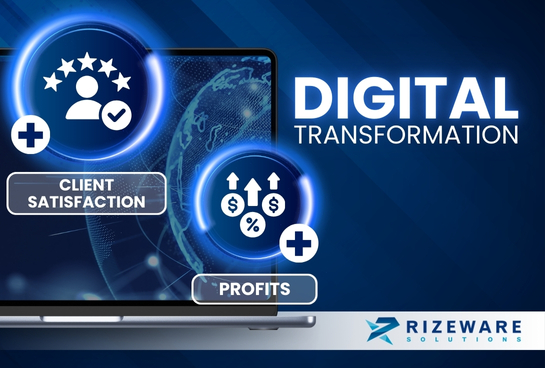A new blog series – Erik Ruda, CEO, Rizeware Solutions
By 2026, organizations worldwide are expected to collectively invest nearly $1.5T in digital transformation initiatives. That’s a massive amount of money for what some people might dismiss as just another set of meaningless industry buzzwords.
But those skeptics make a good point and raise several important questions in the process. What exactly is digital transformation? Why has it become a strategic imperative? What specific benefits would it deliver to organizations? What if you fail? And what is the price tag?
At Rizeware Solutions, a growing part of our business has been focused on helping organizations optimize their own unique digital transformation journeys – and every company is different. Through this experience, we’ve learned a lot about the risks and rewards of this complex process. We want to share some of those insights with you through this new blog series on digital transformation, which will be published weekly. Our goal is to help your organization avoid common pitfalls and be better prepared for a successful journey.
Let’s lay the foundation for this series by first answering a common question every business should be asking – what exactly is digital transformation?
Digital transformation is the process of integrating digital technology into all areas of a business, fundamentally changing how it operates and delivers value to customers. It’s not just about adopting new technologies; it’s about reimagining business processes, culture, and customer experiences in the digital age.
By now, the middle of 2024, we can safely assume that most organizations have already deployed some digital tools and technologies in their organization, and they have no doubt helped improve operations to some extent. But it’s also safe to assume that in too many cases, technology deployments have been more tactical than strategic. That is, they were deployed at different times with different tools in different parts of the business to solve different problems – without any strategic vision for these investments.
Over time, that approach typically resulted in multiple technology silos, each with increasingly outdated legacy systems functioning independently of each other. As a result, these organizations have been unable to achieve the seamless technology integration necessary to help optimize business performance.
This is why the concept of digital transformation has become an imperative. Rather than focusing on disparate, tactical technology deployments, digital transformation is planned and executed as a strategic initiative that creates a whole far greater than the sum of its parts. The benefits of this strategy include improved operational efficiencies, better collaboration between employees, improved data-driven decision making, enhanced customer experience, and much more.
Many different types of organizations can enjoy the benefits of digital transformation, including:
Traditional industries facing disruption:
- Retail facing e-commerce competition
- Banking confronted by fintech startups
- Manufacturing adapting to Industry 4.0
Large enterprises with complex operations:
- Multinational corporations
- Organizations with multiple departments and locations
- Companies with intricate supply chains
Customer service-intensive businesses:
- Telecommunications providers
- Healthcare organizations
- Hospitality and travel companies
Data-rich organizations:
- Insurance companies
- Healthcare providers
- Financial institutions
Businesses with outdated technology infrastructure:
- Companies relying heavily on legacy systems
- Organizations with siloed data and processes
Highly regulated industries:
- Financial services
- Healthcare
- Energy and utilities
Companies losing market share to digital-native competitors:
- Traditional media facing streaming services
- Brick-and-mortar stores competing with online retailers
Organizations with high operational costs:
- Companies with labor-intensive processes
- Businesses with inefficient resource allocation
Businesses seeking to expand or enter new markets:
- Companies looking to scale operations
- Organizations aiming to reach global audiences
Public sector organizations:
- Government agencies aiming to improve citizen services
- Educational institutions adapting to online learning
But, as noted earlier, digital transformation is a “big lift” with a lot of moving parts. It must be planned thoroughly and executed carefully to deliver on its full potential. Throughout this series, we’ll take a closer look at many of the issues and opportunities associated with digital transformation.
Please be sure to follow Rizeware Solutions so that you can stay informed on this topic. As we progress on this journey together, we’ll also include some polling questions so that we can get your feedback on specific topics. And, of course, we’ll share those results with everyone as we move forward.

